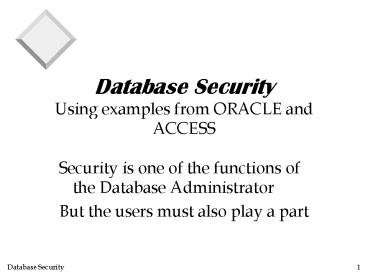Database Security Using examples from ORACLE and ACCESS - PowerPoint PPT Presentation
1 / 17
Title:
Database Security Using examples from ORACLE and ACCESS
Description:
Security is one of the functions of the Database Administrator ... prevents the use of file snoopers which read the system directly, hence ... – PowerPoint PPT presentation
Number of Views:73
Avg rating:3.0/5.0
Title: Database Security Using examples from ORACLE and ACCESS
1
Database SecurityUsing examples from ORACLE and
ACCESS
- Security is one of the functions of the Database
Administrator - But the users must also play a part
2
ORACLE examples
- Security can be consider at four levels
- database
- table
- column
- row
3
Database level security
- Userid and passwords allocated by the DBA
- When you logon to ORACLE you have the privileges
of the userid that you have entered - GRANT RESOURCE,CONNECT,DBA TO username
IDENTIFIED BY password
4
Privileges
- CONNECT - the ability to logon to the database
and access and manipulate tables - RESOURCE - the ability to create tables
- DBA - the ability to
- execute restricted commands
- manipulate data in any table
- create tables
- However these three standard roles can be added
to by the DBA creating roles and adding privileges
5
ACCESS examples
- The DBA needs to set up
- Workgroups
- User Accounts (with or without passwords)
- Permissions
6
Granting permissions
- DBA can grant permission to Users or groups to
perform various operations on - the DB structure
- tables within the structure
- forms, reports, queries and macros
7
Permissions
- Permissions that can be granted depend on what
you are looking at and who is being granted
permission - Database
- Open/Run
- Open Exclusive
- Tables
- Read, Modify design
- Read, Update, Insert, delete data
8
Managing permissions
- Three stages
- Planning
- Establishing the user groups
- Assigning permissions fro the database objects
9
Planning
- Determine overall strategy
- does each user need a unique ID?
- are there logical groupings?
- if multiple database systems are to be used will
they share the same server (and hence same
users/groups)? - Plan will then consist of
- list of all DB applications
- list of all users
- list of logical groups
10
Assigning permissions for DB objects
- Each separate object (table, query, form etc.)
can be assigned its own individual permissions
for each user or group - Permissions stored within the applications MDB
file - Possible to set permissions for all new objects
therefore define settings early in development to
save a lot of time - See Access help under Permissions
11
Database Encryption
- simple process
- transparent to user
- prevents the use of file snoopers which read the
system directly, hence bypassing the security
system
12
Data Encryption in Oracle
- Oracle Database Security -- Data Encryption While
data encryption should not be used as a
substitute for access control, storing data
encrypted does provide an additional layer of
protection on storage media. This helps protect
sensitive data such as credit card numbers in the
event of media theft. Media theft can occur due
to poor physical security, operating system
configuration or backup processes. - Oracle Database 10g Release 2 offers Transparent
Data Encryption (included in Oracle Advanced
Security), which makes encryption of sensitive
data simple by transparently encrypting data when
it is written to disk and decrypting it when it
is read back to the user. Applications that
display credit card numbers for further
processing by a clerk don't have to be modified
to handle the longer, encrypted strings.
Applications and authorized users generally won't
even notice the fact that the data has been
encrypted on the storage media. - http//www.oracle.com/technology/deploy/security/d
b_security/htdocs/enc.html
13
Example from Oracle 10g
- Create table orders
- (order_id number(12) not null
- Customer_id number (12) not null
- Credit_card varchar2(19) encrypt)
14
Database Recovery
- Requirements of Recovery
- Recognition
- Assessment
- Transformation
- Objectives of Recovery
- Minimize loss
- Return to useful state ASAP
- Make recovery automatic as much as possible
- Make non-automatic recovery painless
15
Recovery Resources
- Documentation
- Training
- Backups
- Transaction logs
- Before-images
- After-images
- Diagnostic Fixup programs
16
Managing Recovery
- Recognize the failure
- Determine correct the cause
- Plan a strategy
- Establish a recovery point
- Carry out recovery operation
- Document the proceedings
- Run diagnostics
- Return database to operational status
- Conduct a post mortem
- Update documentation
17
The Cost of Recovery
- Additional I/O
- Additional Processing
- Additional Storage
...but consider the cost of not coping!































